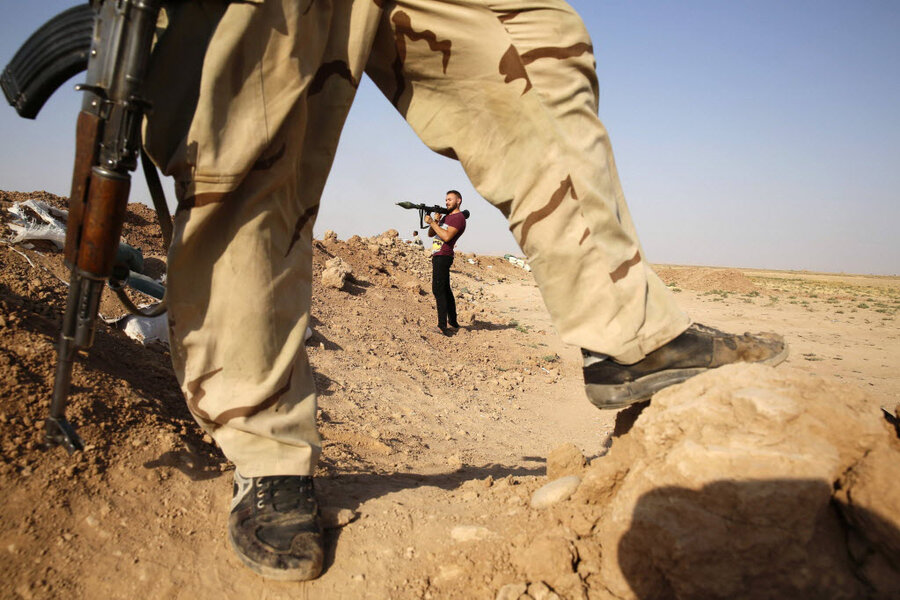What has been the impact of US airstrikes on the Islamic State?
| Washington
In the video showing journalist Steven Sotloff’s death at the hands of the Islamic State, the killer, wearing a black hood, claimed that the brutal beheading was retaliation for US airstrikes against IS forces.
Yet US officials have promised that the military airstrikes will not abate. Indeed, they have continued in the two weeks since the release of another video showing the death of another American journalist, James Foley.
President Obama condemned the killings during a press conference in Estonia Wednesday, saying that IS brutality toward American journalists will only strengthen US resolve to fight the group.
“Whatever these murderers think they’ll achieve by killing innocent Americans like Steven,” he said, “they have already failed.”
So, what has been the impact of airstrikes on IS, also known as ISIS and ISIL? Top Pentagon officials emphasize that there is only so much they can accomplish through airstrikes.
“If we’ve learned nothing over 13 years of war, it’s you can’t completely eliminate extremism anywhere through simply kinetics, through airstrikes alone,” Rear Adm. John Kirby said in a Pentagon briefing last week.
Instead, airstrikes can be used to “contain” IS advances – “but not in perpetuity,” warned Gen. Martin Dempsey, chairman of the Joint Chiefs of Staff, at a recent press briefing.
The US military has launched approximately 110 airstrikes to date against IS, at the cost of approximately $7.5 million a day.
They have been focused on one “very, very clear” and limited mission, Rear Admiral Kirby said. “We are there to support Iraqi and Kurdish forces as they take the fight to ISIL.”
The majority of the strikes have been conducted in and around the Mosul Dam – a key source of water for the country.
Yet while the strikes drove IS fighters out of the area, “ISIL keeps wanting to take it back,“ Kirby said in the briefing last week. “They’re still under attack almost every day there at the facility.”
This continues to be the case, since Iraqi security forces cannot hold the dam on their own, say senior Pentagon officials. “As long as ISIL continues to threaten the facility, we’ll continue to strike them,” Kirby added Wednesday.
These airstrikes against IS formations in Iraq are “very useful in limiting territorial expansion and are essential to rolling back ISIS, because neither Iraqi security forces or the peshmerga” – the Kurdish army in the north of Iraq – “are capable of taking the offensive,” says Christopher Harmer, senior naval analyst at the Institute for the Study of War in Washington. “But in terms of destroying ISIS, we’re not even in the ballgame.”
Instead, the United States has “nibbled at the periphery of ISIS. We’ve nipped at their heels,” adds Mr. Harmer, who served as deputy director of Future Operations for the US Navy’s Fifth Fleet in the region from 2008 to 2009.
From the perspective of IS leadership, halting the momentum of the group has not been a tragedy, he argues. “Right now it’s not the worst thing in the world for them to stop taking new territory and consolidate the gains that they have. You can only process so many new fighters so quickly.”
Meanwhile, IS is still on the offensive in Syria, “gobbling up new territory,” Harmer adds.
Mr. Obama is weighing the possibility of US airstrikes in Syria. In the meantime, he said last week that the airstrikes in Iraq were being used to “degrade” IS’s capabilities.
Military analysts jumped on this point, noting that “degrade” in military parlance is quite different from “destroy.”
Pentagon officials say they will not elaborate on the president’s comments. “I don’t make policy here,” Kirby told reporters last week, emphasizing once again that military strikes alone will not be sufficient to take on IS.
“Whatever the options are for Syria, it’s not just going to be military,” Kirby said. “It can’t just be military. There’s not going to be a military solution here to the threat ISIL poses. It’s just not going to happen.”





